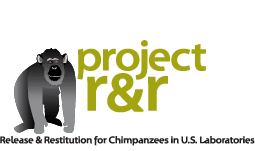January 23, 2013 • Posted in Project R&R News
Yesterday, a National Institutes of Health (NIH)-appointed Council of Councils (CoC) Working Group on Chimpanzees in Research announced findings from its NIH-directed study. NIH requested that it develop a plan to implement the Institute of Medicine’s (IOM) guiding principles and criteria for chimpanzee research, analyze the current use of chimpanzees in research, assess the placement and size of chimpanzee populations, and review potential future use.
The announcement is a third major coup in our work to end the use of chimpanzees in U.S. research. In December 2010, the NIH commissioned an IOM study to assess whether chimpanzees are or will be necessary for biomedical and behavioral research. One year later, the IOM issued stringent recommendations following their finding that chimpanzees are not needed in most areas of current research. Immediately following the IOM report, NIH Director Dr. Francis Collins announced they were committed to adopting the IOM recommendations. NIH appointed the CoC Working Group to recommend how to best implement the IOM findings, thus continuing momentum at the highest levels of government to end U.S. chimpanzee use.
The CoC has submitted the report to Dr. Collins for consideration for adoption. In this NEAVS eALERT’s brief and timely summary of the three-hour presentation and media Q&A, we want to highlight that of 451 identified NIH-owned or -supported chimpanzees currently held in U.S. labs and available for research, the Working Group recommended approximately 90% of them be retired from research and transferred to sanctuary within three to five years. The report states, “research involving chimpanzees has rarely accelerated new discoveries or the advancement of human health for infectious diseases,” and “there is no compelling scientific reason to maintain a sufficiently large reserve population of chimpanzees suitable and/or available for infectious disease research.” The report does stipulate a recommendation to maintain a small population of 50 chimpanzees for possible future research. However, that number is recommended to be reconsidered every five years. As part of their charge to assess current use of chimpanzees in research, the Working Group recommended an end to two-thirds of all current biomedical studies involving chimpanzees.
The Working Group recommendations, which were voted 13-0 for approval by the full CoC, acknowledge any and all theoretical potential future use of chimpanzees must be subjected to a strict independent oversight committee to assess whether their use is acceptable, critical, and meets all IOM guidelines – including housing in an ethologically appropriate environment. Among the most important factors defined by the Working Group as to what constitutes an ethologically appropriate environment was that chimpanzees be allowed “choice and self-determination” and that they be maintained in a “culture of care” to “engender respect and mutuality of positive human-animal relationships.” However, in the event of such a proposed future need for research into new or emerging diseases for which only a chimpanzee is deemed suitable, there are, in addition to ethical issues and the lack of scientific basis for such a use, practical limitations in that no U.S. bio-safety laboratory is suitable for nor designed to accommodate chimpanzees.
NIH will now review the Working Group’s findings during a 60-day public comment period before it issues its decision on adopting the recommendations – expected in late March. NEAVS is committed to getting the recommendations adopted, will be submitting comments on the report to the NIH, and is cautiously optimistic about NIH’s upcoming decision. If NIH adopts the recommendations, NEAVS will prioritize making certain the 50 chimpanzees held for possible future use will NEVER be used. Watch for upcoming reports on this and other positive developments in NEAVS’ Project R&R: Release and Restitution for Chimpanzees in U.S. Labs campaign.
To read NEAVS' comments in full, click here.
For more information, see the New York Times article “Health Agency Moves to Retire Most Chimps Used for Research.”

